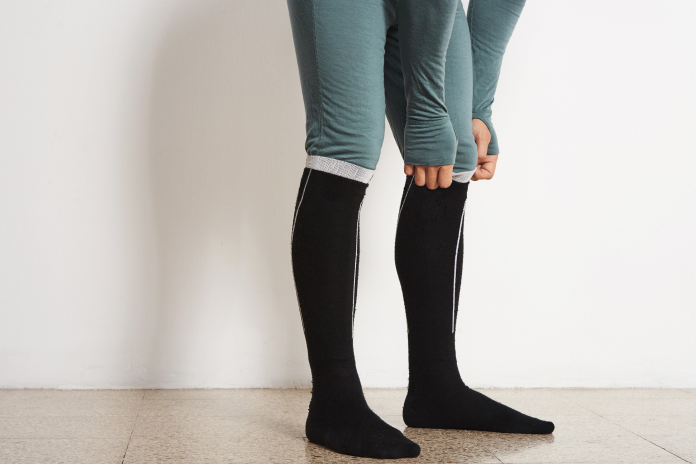Running is one of the most popular forms of exercise because it offers numerous health benefits Whether you’re a seasoned marathon runner or enjoy occasional jogs around the neighborhood, it’s essential to prioritize your comfort and well-being during your runs.
One way to enhance your running experience and promote better performance is by wearing compression socks.
In this article, we will explore the medical advantages of compression socks for runners.
From improved circulation to reduced muscle soreness, let’s uncover the incredible benefits that compression socks bring to your running routine.
1. Enhanced Blood Circulation:
Compression socks for runners are designed to apply gentle pressure to the lower legs, ankles, and feet. This graduated compression technology works wonders for blood circulation.
The socks compress the veins, helping to improve the flow of blood back to the heart.
By promoting efficient circulation, compression socks can reduce the risk of blood pooling in the lower extremities, preventing discomfort and potential complications such as deep vein thrombosis (DVT).
Improved circulation also means oxygen and nutrients are delivered more efficiently to the muscles, enhancing overall performance and reducing fatigue during runs.
2. Reduced Muscle Fatigue and Soreness:
Running can take a toll on your leg muscles, leading to fatigue and soreness.
Compression socks provide targeted compression, which helps stabilize the calf muscles and reduces muscle oscillation during running. This stabilization can decrease muscle vibrations and micro-tears, thereby minimizing muscle damage and post-run soreness.
By wearing compression socks during your runs, you can potentially experience faster recovery times and be ready for your next workout sooner.
3. Prevention of Shin Splints:
Shin splints are a common complaint among runners, characterized by pain along the shinbone. Compression socks can play a crucial role in preventing and managing shin splints.
The compression provides gentle support to the calf muscles and helps stabilize the lower leg, reducing excessive muscle movement and stress on the shinbone.
This added support can alleviate discomfort and contribute to a more comfortable and enjoyable running experience.
4. Minimized Swelling and Edema:
Many runners experience swelling and edema in their lower legs and feet, especially after prolonged or intense workouts.
Compression socks work wonders in reducing this swelling by promoting efficient fluid movement through the lymphatic system. The graduated compression helps prevent fluid buildup and facilitates the removal of metabolic waste products, reducing post-run swelling and discomfort.
Say goodbye to puffy feet and ankles and hello to a more comfortable recovery after your runs.
5. Injury Prevention and Support:
Running puts stress on various parts of the body, including the ankles, shins, and feet.
Compression socks provide valuable support to these vulnerable areas. The compression can help stabilize the ankle joint, reducing the risk of ankle sprains or twists. Additionally, compression socks can provide mild arch support, which is beneficial for runners with flat feet or high arches.
This added support and stability can prevent overpronation or supination, reducing the likelihood of common running injuries such as plantar fasciitis or Achilles tendonitis.
6. Temperature Regulation:
Compression socks are often made from moisture-wicking materials that help regulate body temperature.
During runs, they can help keep your legs cool and dry by wicking away sweat. In colder temperatures, compression socks provide a layer of insulation, keeping your muscles warm and preventing them from cooling too quickly.
This temperature regulation can contribute to optimal muscle function and overall running performance.
7. Expedited Recovery:
Recovery is an essential aspect of any training routine, and compression socks can play a significant role in expediting the recovery process for runners.
After a challenging run, wearing compression socks helps increase blood flow and oxygen delivery to fatigued muscles.
By wearing compression socks during the recovery phase, runners may experience reduced muscle soreness, quicker muscle repair, and a faster return to their training regimen.
So, slip on those compression socks after your run, and let them work their magic in accelerating your recovery.
When it comes to enhancing your running experience and reaping the maximum benefits from your workouts, don’t underestimate the power of compression socks.
These remarkable garments provide a range of medical advantages for runners, including enhanced blood circulation, reduced muscle fatigue and soreness, prevention of shin splints, minimized swelling and edema, injury prevention and support, temperature regulation, and expedited recovery.
By incorporating compression socks into your running routine, you can optimize your performance, minimize discomfort, and enjoy a more rewarding running experience.
So, lace up your running shoes, slide on a pair of compression socks, and hit the pavement with confidence. Your legs will thank you, and you’ll be well on your way to reaching new running milestones!
Image by bublikhaus from freepik
The editorial staff of Medical News Bulletin had no role in the preparation of this post. The views and opinions expressed in this sponsored post are those of the advertiser and do not reflect those of the Medical News Bulletin. Any Web sites linked from Medical News Bulletin site are created by organizations outside of Medical News Bulletin and are the sole responsibility of those organizations. These links are strictly provided by Medical News Bulletin as a convenience to you for additional information only. Medical News Bulletin does not approve or endorse the content on any third-party Web sites and is not responsible for the content of linked third-party sites or third-party advertisements, as well as does not make any representations regarding their content or accuracy. Your use of third-party web sites is at your own risk and subject to the terms and conditions of use as per such sites policies. Medical News Bulletin does not provide specific medical advice, diagnosis or treatment and hereby disclaims any assumption of any of the obligations, claims or liabilities..



